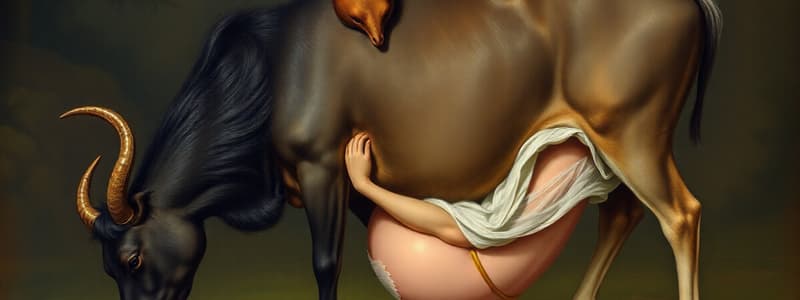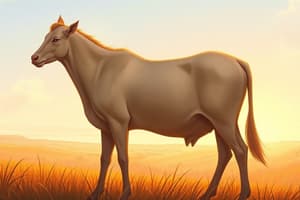Podcast
Questions and Answers
What is the average gestation period for a cow?
What is the average gestation period for a cow?
- 200 days
- 300 days
- 283 days (correct)
- 365 days
What part of the cow's reproductive system is primarily responsible for fertilization?
What part of the cow's reproductive system is primarily responsible for fertilization?
- Cervix
- Oviducts (correct)
- Uterus
- Vagina
Which hormone is responsible for stimulating the synthesis of LH and FSH?
Which hormone is responsible for stimulating the synthesis of LH and FSH?
- Testosterone
- Progesterone
- Estrogen
- Gonadotropin Releasing Hormone (GnRH) (correct)
What duration does oestrus typically last in a cow?
What duration does oestrus typically last in a cow?
What is one major drawback of artificial insemination concerning expertise?
What is one major drawback of artificial insemination concerning expertise?
What role does the uterus play during gestation?
What role does the uterus play during gestation?
Why can artificial insemination be considered a cost-effective method?
Why can artificial insemination be considered a cost-effective method?
During the bovine oestrous cycle, what is the primary role of progesterone (P4)?
During the bovine oestrous cycle, what is the primary role of progesterone (P4)?
What is a potential consequence of reliance on a few selected bulls in artificial insemination?
What is a potential consequence of reliance on a few selected bulls in artificial insemination?
What is the site of sperm deposition in the cow reproductive tract?
What is the site of sperm deposition in the cow reproductive tract?
What is the process called when ruminants regurgitate their food to chew it again?
What is the process called when ruminants regurgitate their food to chew it again?
What dietary factor primarily leads to ruminant acidosis in cattle?
What dietary factor primarily leads to ruminant acidosis in cattle?
What is the main symptom of bloat in ruminants?
What is the main symptom of bloat in ruminants?
How can cattle acidosis be effectively prevented?
How can cattle acidosis be effectively prevented?
What role do microbes play in the digestive process of ruminants?
What role do microbes play in the digestive process of ruminants?
How does HCl contribute to the digestive process in ruminants?
How does HCl contribute to the digestive process in ruminants?
What occurs when excessive acid accumulates in the rumen?
What occurs when excessive acid accumulates in the rumen?
What happens to food during digestion in the stomach of ruminants?
What happens to food during digestion in the stomach of ruminants?
What is the primary role of the reticulum in ruminants?
What is the primary role of the reticulum in ruminants?
What is the function of the omasum in ruminant digestion?
What is the function of the omasum in ruminant digestion?
What are the four compartments of a ruminant's stomach?
What are the four compartments of a ruminant's stomach?
How do the teeth of ruminants differ in purpose from those of monogastric animals?
How do the teeth of ruminants differ in purpose from those of monogastric animals?
What role do microorganisms play in the digestion of ruminant animals?
What role do microorganisms play in the digestion of ruminant animals?
Describe the purpose of saliva in the digestive process of cattle.
Describe the purpose of saliva in the digestive process of cattle.
How does the presence of flat premolars benefit ruminants?
How does the presence of flat premolars benefit ruminants?
What is the primary difference between the diet of ruminants and monogastrics?
What is the primary difference between the diet of ruminants and monogastrics?
What is rumination and why is it important for ruminants?
What is rumination and why is it important for ruminants?
How does excessive intake of carbohydrate-rich feeds lead to ruminant acidosis?
How does excessive intake of carbohydrate-rich feeds lead to ruminant acidosis?
How can farmers manage their cattle to prevent bloat?
How can farmers manage their cattle to prevent bloat?
What is the role of microbes in the fermentation process of ruminants?
What is the role of microbes in the fermentation process of ruminants?
Describe the significance of pepsinogen activation in ruminants.
Describe the significance of pepsinogen activation in ruminants.
What dietary changes occur in the rumen when transitioning to high grain diets?
What dietary changes occur in the rumen when transitioning to high grain diets?
What happens to food in the ruminant stomach following initial ingestion?
What happens to food in the ruminant stomach following initial ingestion?
Explain the relationship between HCl and pepsinogen during digestion in ruminants.
Explain the relationship between HCl and pepsinogen during digestion in ruminants.
What components are absorbed in the small intestine of ruminants?
What components are absorbed in the small intestine of ruminants?
How do the structural differences in the digestive systems of ruminants and monogastrics affect their diets?
How do the structural differences in the digestive systems of ruminants and monogastrics affect their diets?
In what ways do the incisors and molars contribute to the digestion of ruminants?
In what ways do the incisors and molars contribute to the digestion of ruminants?
What is the significance of anaerobic digestion for ruminants?
What is the significance of anaerobic digestion for ruminants?
Explain the role of saliva in the digestive process of cattle.
Explain the role of saliva in the digestive process of cattle.
What role do flat premolars play in the digestion of ruminants?
What role do flat premolars play in the digestion of ruminants?
What is the primary purpose of the reticulum in ruminants?
What is the primary purpose of the reticulum in ruminants?
Why is the dental formula significant in differentiating ruminants from monogastrics?
Why is the dental formula significant in differentiating ruminants from monogastrics?
Flashcards are hidden until you start studying
Study Notes
Cow Reproductive Facts
- Oestrus duration in cows is 14 to 24 hours, indicating the period when the cow is receptive to mating.
- Average gestation period for a cow is 283 days, essential for fetal development.
- Fertilization in cows occurs in the oviducts, where the sperm meets the egg.
- The uterus plays a crucial role in gestation, providing nourishment and protection to the embryo and fetus.
- Luteinizing hormone (LH) is primarily responsible for causing ovulation in cows.
- The cervix's function is to prevent infection, serving as a barrier in the reproductive tract.
Hormonal Influences
- Gonadotropin Releasing Hormone (GnRH) stimulates the synthesis of LH and FSH, key hormones in the reproductive cycle.
- Progesterone (P4) promotes the maintenance of pregnancy during the bovine oestrous cycle.
Artificial Insemination (AI) Insights
- AI enables the use of superior genetics from top bulls, enhancing traits such as milk production and disease resistance.
- AI is cost-effective as it eliminates the need for maintaining a bull, which incurs expenses for feeding, housing, and veterinary care.
- AI practices reduce the risk of transmitting sexually transmitted diseases, promoting healthier herds.
- One major disadvantage of AI is the requirement for skilled personnel, which may be scarce in some regions.
- Relying heavily on a few selected bulls can decrease genetic diversity, increasing the risk of inbreeding issues.
Herd Health Management
- AI minimizes disease transmission risks associated with natural mating, contributing to improved herd health.
Ruminant Digestion Process
- Ruminants regurgitate food for additional chewing, a process called rumination.
- Their stomach contains four compartments: rumen, reticulum, omasum, and abomasum.
Acidosis in Cattle
- Ruminant acidosis results from excessive ingestion of fermentable, carbohydrate-rich feeds.
- Preventive measures include proper feeding and management practices.
Bloat in Ruminants
- The primary sign of bloat is gas accumulation in the rumen without effective release, causing discomfort.
Fermentation and Gas Production
- Gas generation in the rumen is a natural by-product of fermentation.
- Improper gas release can cause bloat, leading to health complications.
Rumen Microbiome
- Ruminants rely on a symbiotic relationship with microbes that assist in food fermentation in the rumen.
Stomach Composition and Function
- Hydrochloric acid (HCl) maintains a pH of 2 in the stomach, crucial for digestion.
- Pepsinogen converts to pepsin in the acidic environment, necessary for starting protein digestion.
- Gastric juices facilitate the chemical breakdown of ingested food.
Digestive Processes
- Food undergoes both chemical and physical breakdown by gastric juices and muscular contractions.
- The acidic environment enhances protein digestion by activating pepsinogen to pepsin.
Dietary Adaptations
- Transitioning to high-grain diets requires the rumen to adapt to enhance grain digestion efficiency.
- Adequate fiber intake promotes rumen movement and peristalsis.
Ruminant Stomach Functions
- The reticulum collects smaller digesta and facilitates microbial fermentation.
- The omasum absorbs water and nutrients.
Nutrient Absorption
- In the small intestine, nutrients such as amino acids, glucose, vitamins, and minerals are absorbed into capillaries.
Dental Differences
- Ruminant dentition: unique dental formula (0 I 0 C 3 PM 3 M) differs from monogastrics.
- Ruminants have specific dental structures that aid in processing fibrous plant material.
Microbial Role in Digestion
- Microorganisms in ruminants break down cellulose and complex carbohydrates through fermentation.
Role of Saliva
- Saliva serves as a lubricant, aids in chewing and swallowing, and initiates food breakdown.
Importance of Anaerobic Digestion
- Anaerobic digestion allows ruminants to efficiently ferment plant material, maximizing nutrient absorption.
Functions of Teeth
- Incisors cut and bite, while molars crush and grind food; flat premolars enhance grinding performance for fibrous material.
Ruminant Digestion Process
- Ruminants regurgitate food for additional chewing, a process called rumination.
- Their stomach contains four compartments: rumen, reticulum, omasum, and abomasum.
Acidosis in Cattle
- Ruminant acidosis results from excessive ingestion of fermentable, carbohydrate-rich feeds.
- Preventive measures include proper feeding and management practices.
Bloat in Ruminants
- The primary sign of bloat is gas accumulation in the rumen without effective release, causing discomfort.
Fermentation and Gas Production
- Gas generation in the rumen is a natural by-product of fermentation.
- Improper gas release can cause bloat, leading to health complications.
Rumen Microbiome
- Ruminants rely on a symbiotic relationship with microbes that assist in food fermentation in the rumen.
Stomach Composition and Function
- Hydrochloric acid (HCl) maintains a pH of 2 in the stomach, crucial for digestion.
- Pepsinogen converts to pepsin in the acidic environment, necessary for starting protein digestion.
- Gastric juices facilitate the chemical breakdown of ingested food.
Digestive Processes
- Food undergoes both chemical and physical breakdown by gastric juices and muscular contractions.
- The acidic environment enhances protein digestion by activating pepsinogen to pepsin.
Dietary Adaptations
- Transitioning to high-grain diets requires the rumen to adapt to enhance grain digestion efficiency.
- Adequate fiber intake promotes rumen movement and peristalsis.
Ruminant Stomach Functions
- The reticulum collects smaller digesta and facilitates microbial fermentation.
- The omasum absorbs water and nutrients.
Nutrient Absorption
- In the small intestine, nutrients such as amino acids, glucose, vitamins, and minerals are absorbed into capillaries.
Dental Differences
- Ruminant dentition: unique dental formula (0 I 0 C 3 PM 3 M) differs from monogastrics.
- Ruminants have specific dental structures that aid in processing fibrous plant material.
Microbial Role in Digestion
- Microorganisms in ruminants break down cellulose and complex carbohydrates through fermentation.
Role of Saliva
- Saliva serves as a lubricant, aids in chewing and swallowing, and initiates food breakdown.
Importance of Anaerobic Digestion
- Anaerobic digestion allows ruminants to efficiently ferment plant material, maximizing nutrient absorption.
Functions of Teeth
- Incisors cut and bite, while molars crush and grind food; flat premolars enhance grinding performance for fibrous material.
Studying That Suits You
Use AI to generate personalized quizzes and flashcards to suit your learning preferences.




